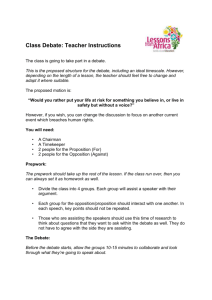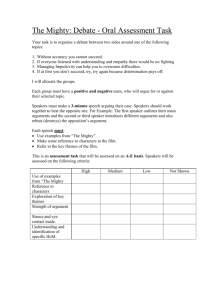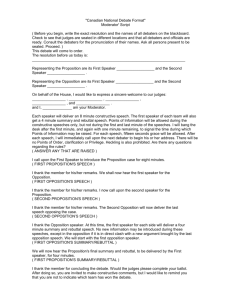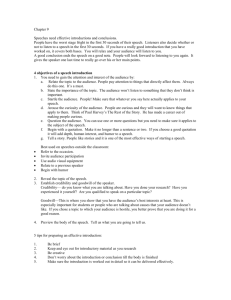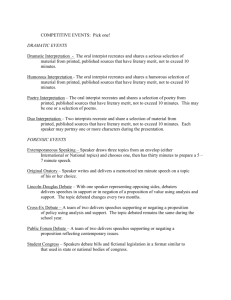Karl Popper vs. WSDC Debate Formats: Overview
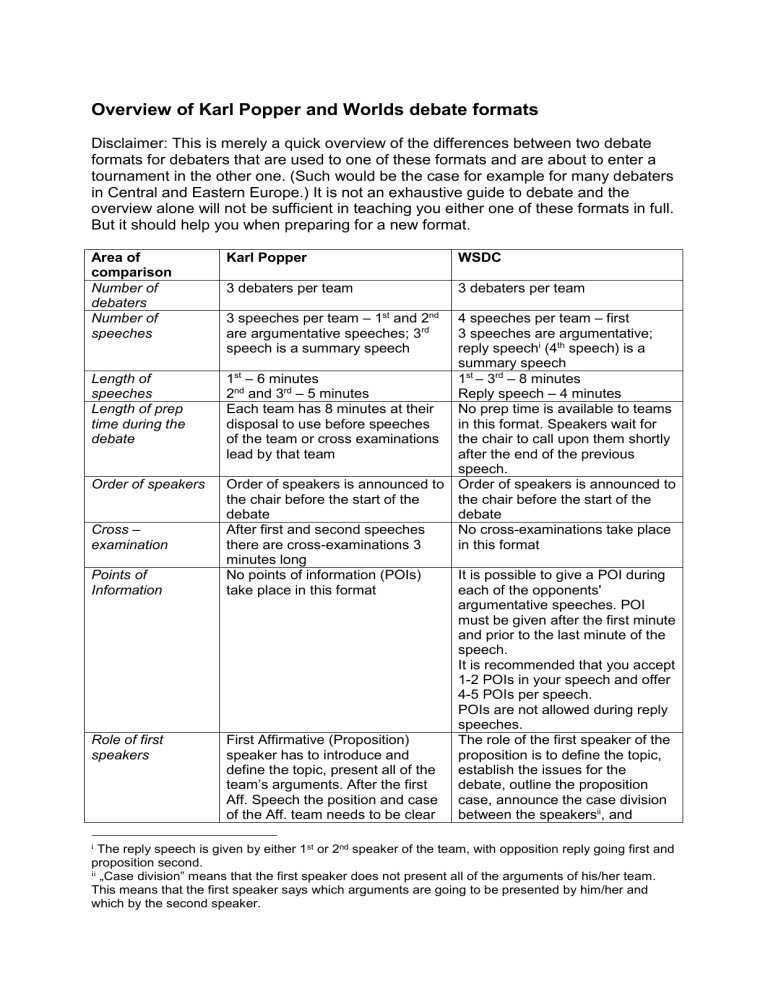
Overview of Karl Popper and Worlds debate formats
Disclaimer: This is merely a quick overview of the differences between two debate formats for debaters that are used to one of these formats and are about to enter a tournament in the other one. (Such would be the case for example for many debaters in Central and Eastern Europe.) It is not an exhaustive guide to debate and the overview alone will not be sufficient in teaching you either one of these formats in full.
But it should help you when preparing for a new format.
Karl Popper WSDC Area of comparison
Number of debaters
Number of speeches
3 debaters per team
3 speeches per team – 1 st and 2 nd are argumentative speeches; 3 rd speech is a summary speech
3 debaters per team
Length of speeches
Length of prep time during the debate
1 st – 6 minutes
2 nd and 3 rd – 5 minutes
Each team has 8 minutes at their disposal to use before speeches of the team or cross examinations lead by that team
Order of speakers Order of speakers is announced to the chair before the start of the debate
Cross – examination
After first and second speeches there are cross-examinations 3 minutes long
Points of
Information
No points of information (POIs) take place in this format
4 speeches per team – first
3 speeches are argumentative; reply speech i (4 th speech) is a summary speech
1 st – 3 rd – 8 minutes
Reply speech – 4 minutes
No prep time is available to teams in this format. Speakers wait for the chair to call upon them shortly after the end of the previous speech.
Order of speakers is announced to the chair before the start of the debate
No cross-examinations take place in this format
Role of first speakers
First Affirmative (Proposition) speaker has to introduce and define the topic, present all of the team’s arguments. After the first
Aff. Speech the position and case of the Aff. team needs to be clear
It is possible to give a POI during each of the opponents' argumentative speeches. POI must be given after the first minute and prior to the last minute of the speech.
It is recommended that you accept
1-2 POIs in your speech and offer
4-5 POIs per speech.
POIs are not allowed during reply speeches.
The role of the first speaker of the proposition is to define the topic, establish the issues for the debate, outline the proposition case, announce the case division between the speakers ii , and i The reply speech is given by either 1 st or 2 nd speaker of the team, with opposition reply going first and proposition second. ii „Case division” means that the first speaker does not present all of the arguments of his/her team.
This means that the first speaker says which arguments are going to be presented by him/her and which by the second speaker.
Role of second speakers
Role of third speakers
Role of Reply speeches
Definitions
Definitions – case where the teams agree on the enough for the debate to be able to continue.
First Neg. (Opposition) speaker has to accept or reject the definitions presented by prop, react to the Aff. arguments and present all of their own counterarguments. Position and case of
Neg. team should be clear after the first Neg. speech
Primary role of the second speaker of Affirmative team is to rebuild and elaborate on their arguments (their case) and react to the arguments presented by the
Negative team
Primary role of the second speaker of Negative team is to react to the arguments and rebuttals of the Affirmative team, especially the second speaker. He or she should also rebuilt and elaborate the arguments of the
Neg. team
Third speakers should summarize the debate from their team’s viewpoint. Third speeches should identify and analyze the main areas of clash.
Non-existent present his or her part of the proposition case.
The role of the first speaker of the opposition side is to challenge the definition if necessary, present an alternative definition if the definition is challenged, respond to the proposition case, outline the opposition case, announce the case division, and devote most of his or her time (about six minutes) to presenting his or her part of the opposition case.
The role of the second speaker of the proposition is to deal with the definition if it has been challenged, respond to the opposition case, and devote about four minutes to continuing with the proposition case as outlined by the first speaker.
The role of the second speaker of the opposition is to deal with the definition if it is still an issue, respond to the proposition case, and devote about four minutes to continuing with the opposition case as outlined by the first speaker.
The roles of both third speakers is to deal with the definition if it is still in issue, and primarily respond to the other team's case, so these speakers are similar to second speakers in Karl Popper.
The role of the reply speeches is to sum up the debate from the team's viewpoint, including a response to the other team's overall case and a summary of the speaker's own team's case, so these speeches are similar to third speeches in Karl Popper.
No variation from the Slovak version of Karl Popper.
Definitions provided should be based on a common sense understanding of the motion. They have to provide reasonable room for opposition (i.e. there must be clear controversy) so that a debate can take place.
If the Negative team agrees with the definitions presented by the
Affirmative team, then the debate
No variation from the Slovak version of Karl Popper.
proposed definitions
Definitions – case where the teams disagree on the proposed definitions
Types of motions and cases
The scope of motions and cases. is judged within the boundaries of these proposed definitions. This applies even if these definitions are not in line with a common sense understanding of the motion.
If the Negative team disagrees with the definitions presented by the Affirmative team and presents their own (providing adequate explanation), then the debate is judged based upon the set of definitions by the team which does a better job of arguing that their definitions are more in line with a common sense understanding of the motion.
Note that the winner of this definitional debate is not automatically the winner of that debate.
All types of motions or cases
(value, policy, comparative, cause and effect, etc.) can be used as long as they are closed motions or semi-open motions.
Some motions are about general principles, while others are about particular situations in particular countries, depending on the debate setting (local vs. international tournament).
No variation from the Slovak version of Karl Popper.
No variation from the Slovak version of Karl Popper.
Because the format was developed in an international setting, motions are rather general than particular. Even policy motions are rarely about particular solutions; policies are rather defended as general “models.” iii iii „This House believes Kosovo should be independent“, is rather an exception here. A good example would be „This House supports a flat tax“.

